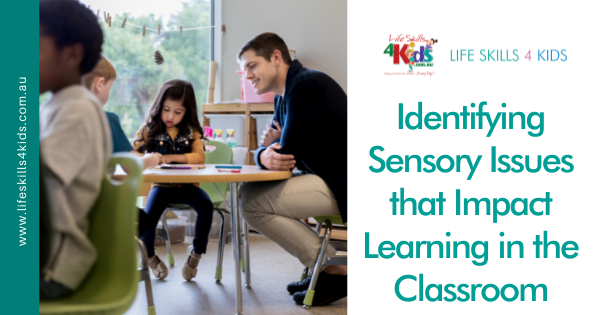Written By Deb Hopper, Occupational Therapist
Sensory issues that impact learning
Teaching in classrooms can be challenging, but also can be extremely rewarding. There is such a mix of students these days with learning disabilities, diagnoses including autism, ADHD, other developmental difficulties, kids with trauma and a history of abuse, other behavioural difficulties, as well as typical learners and gifted and talented students. It is a hard call for a teacher to engage all levels of students throughout the learning day and week. My admiration for teachers is truly astounding! With such a diverse range of students, sensory issues that impact learning is an area that is developing current research.
Sensory issues that impact learning can contribute to the discussion about how to set up responsive classrooms, how to teach and encourage children’s emotional resilience from day to day and strategies for classroom management techniques of behaviour.
So why bother with the sensory piece in the classroom? This concept of the impact and benefit of considering sensory processing in classrooms is well understood by many teachers and schools, however, in some classrooms and schools that I visit locally and in my travels around the country, the concept of considering the sensory piece of classroom environments and behaviour management strategies is a foreign concept.
So what is sensory processing?
Sensory processing disorder when our sensory signals from our environment get misinterpreted and cause difficulty in being able to do a task we need to do, or impact on our ability to self regulate our emotions and behaviour.
The sensory system takes information from the surrounding environment through touch, smell, sound, vision, taste, movement, and gravity.
It processes or interprets these sensations together to make sense of the environment. The process of sensory integration lays the foundation for the efficient operation of the nervous system and other parts of the body that respond to the signals sent by the nervous system. The child then responds to these sensory inputs and makes appropriate responses to perform skills required.
These difficulties put children with SPD at high risk for many emotional, social, and educational problems, including the inability to make friends or be a part of a group, poor self-concept, academic failure, and being labelled clumsy, uncooperative, belligerent, disruptive, or “out of control.” Anxiety, depression, aggression, or other behaviour problems can follow. Parents may be blamed for their children’s behaviour by people who are unaware of the child’s “hidden handicap.”
Why bother with sensory issues in class?
Teachers would be the first to agree that the classroom is a very sensory rich environment. The sensory environment can have a massive impact on children’s ability to
- Concentrate and engage in learning
- Control distractibility in the classroom environment
- Manage anxiety levels
- Self regulate their behaviour and their emotions
- Plan, organise and sequence tasks in the correct order and in the correct timing.
Clever Classrooms Research (2015)
The Clever Classrooms Research has completed a research program on the effects of the classroom environment and it’s relationship to learning. In this study, 153 classrooms were studied in 27 schools. The single most important finding reported here, “is that there is clear evidence that the physical characteristics of primary schools do impact on pupils’ learning progress in reading, writing and mathematics” (Clever Classrooms p 14).
Sensory aspects that can decrease learning, increase anxiety and increase distractibility in classrooms
So what are the three big sensory aspects of your classroom environment that can be distracting or reduce learning in your classroom, and take away from your awesome and passionate teaching sessions.
By focusing on these three big sensory issues, and making some small changes, you can increase the learning potential of students in your classroom.
1. The Visual Sensory Environment – visual busyness, too many displays on the walls, displays of crafts or other visuals that are not visually organised, glare off the white board and smart board, not enough natural light, the flickering of fluorescent lights. There are so many visual issues to consider in your classroom. Introduce strategies such as colour blocking (placing similar posters with a block of bold colour behind them to group them together, using light filters on fluorescent light to cut out the flickering and monitoring the glare are simple strategies to start on fine tuning the visual environment.
2. Noise – Noise can be created inside the classroom with the passionate discussions of children, movement of chairs in and out in transitions, white noise from fans or air conditioners, or noise coming from outside the classroom. Also the auditory processing impacts on the volume and frequency of the teacher’s voice and where they stand and how they project their voice can also have big impacts on children’s learning.
3. Seating and positioning of seating – Most seating in classrooms is static seating, where children are expected to sit and concentrate for medium to long sessions. Introducing dynamic seating such as being allowed to sit on a ball chair or an exercise ball or seats that allow movement “in seat” are fantastic additions to the classroom. Options for standing desks and high seat desks are great options to, so that children can look ‘over’ the heads of children in front, further reducing visual distractions as well. Regular movement brains also help to ‘refill’ their sensory systems and can improve levels of concentration and emotional regulation.
How can you take a fresh look at your classroom sensory environment?
Take our Free Classroom Assessment Now to ensure your teaching environment is sensory safe
1. Our free Classroom assessment tool is a great place to start understanding and looking at your classroom from a new viewpoint.
2. Download our FREE Sensory Strong Classrooms ebook
3. The School Environment Sensory Checklist
4. The 20 Day Classroom Detox – The 20 Day Classroom Detox is an accredited online course to guide teachers step-by-step on how to assess and make changes to the classroom and ensure best practices for creating ideal learning spaces.

